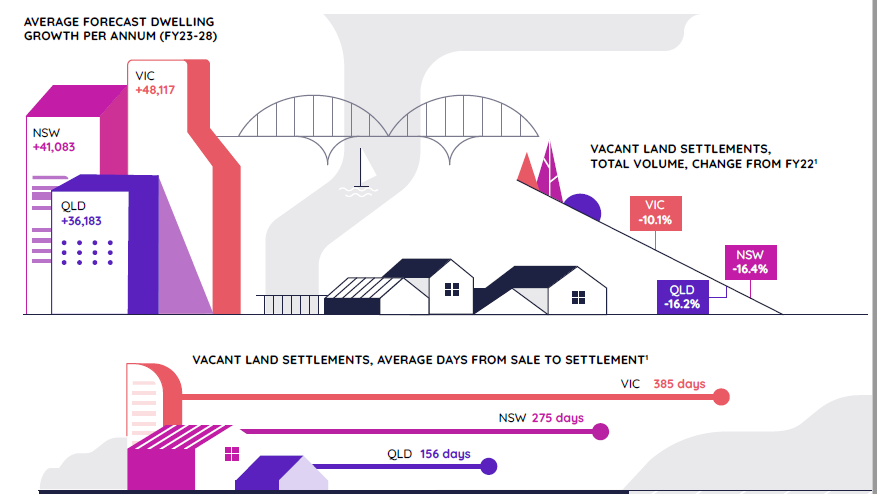Settlements on new residential land fell across the eastern states in FY23

NSW and Queensland are not releasing enough land to keep pace with new housing demand, while it takes Victoria an average of more than a year to settle a vacant block, according to new PEXA analysis.
The inaugural research, titled Residential Land Report, published by PEXA and Informed Decisions (.id), has revealed that settlements on new residential land declined across all three eastern states to 73,901 in the 2023 financial year, a fall of 13.6%.
Over the same period, continued demand has led to sharply higher cost of vacant lots in all three states, with Greater Sydney’s median closing in on $500,000 for the first time. This meant the total value of settlements across the three states slipped less than total volumes – about 7.4% to $36.8bn.
Analysis showed that considering the imbalance between land supply and demand, LGAs in NSW and Queensland would have to build thousands of new units to meet forecast demand in the next five years, with only Victoria currently releasing enough new land to address the dwelling growth over said period.
The report, which analysed the latest trends in the settlement of vacant greenfield land for low-density dwelling across NSW, Queensland, and Victoria from July 2020 to June 2023, also revealed the following key findings:
- Total vacant land settlements in the three eastern states dropped 13.6% to 73,901, with each state posting sizable declines in volumes compared to FY22.
- Average days from settlement were highest in Victoria, at 385 days, up from 243 days in FY22. NSW and Queensland released land faster, with buyers waiting an average 275 days and 156 days, respectively.
- Victoria delivered higher volumes of new vacant residential land relative to other states, with 33,847 settlements in FY23 (down 10.1%), representing nearly one in five settlements in the state.
- Queensland delivered 24,226 vacant land settlements in FY23 (down 16.2%). But in many key greenfield LGAs, particularly in fast-growing Southeast Queensland, land released was below forecast dwelling growth.
- NSW posted the weakest new land supply, delivering well-below forecast dwelling growth of just 15,828 vacant land settlements in FY23 (down 16.4%).
- Settlement values for vacant land rose in all eastern states as volumes tightened, with new blocks in Greater Sydney up 13.5% to an average of $489,764, new blocks in Greater Melbourne up 6.3% to $288,607, and new blocks in Greater Brisbane up 9.4% to $248,295.
- The greenfield LGAs with the greatest need for more medium- to high-density housing in the next five years are Brisbane in Queensland (5,035 units required) and Blacktown (1,527), Liverpool (1,135), and Camden (1,614) in NSW. Most greenfield LGAs in Victoria are meeting or close to meeting dwelling forecasts.

Mike Gill (pictured above), PEXA head of research, said many Australians, particularly families and first-home buyers, prefer to build a new home in a greenfield housing estate.
“They are drawn to the lower prices compared to established suburbs and the ability to build a large, new, freestanding home to their own specifications,” Gill said. “That’s why this analysis is so valuable as we seek solutions to address the nation’s housing affordability crisis.”
The PEXA leader said the first-of-its-kind report, which provides a balanced and realistic view of when and where growth in both population and housing will occur in the future, highlighted that we can’t rely solely on greenfield developments on the nation’s urban fringes to meet the housing demands of a growing Australia.
“People want to live in cities for access to education and employment, and it’s our cities that are best placed to deliver these services, as opposed to creating new and disconnected communities on our cities’ fringes,” he said.
Ivan Motley, founder of .id, said densification in Australia’s established urban areas is necessary to meet the demands for appropriate and affordable housing of the nation’s growing population.
“We’ve been working with governments and organisations in the private sector for over 25 years to help them understand and plan for the nuances of our local communities and how they are changing,” Motley said.
“In the post pandemic era, the role our cities play as the epicentre of housing supply and demand is more important than ever, and we are working with public and private sector organisations to help them plan for the unique needs of different local areas over the next quarter century.”
Access the full Residential Land Report at www.pexa.com.au/content-hub/.
Get the hottest and freshest mortgage news delivered right into your inbox. Subscribe now to our FREE daily newsletter.



